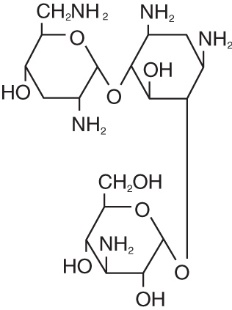Tobramycin by Redpharm Drug TOBRAMYCIN solution
Tobramycin by
Drug Labeling and Warnings
Tobramycin by is a Prescription medication manufactured, distributed, or labeled by Redpharm Drug. Drug facts, warnings, and ingredients follow.
Drug Details [pdf]
-
DESCRIPTION
Tobramycin ophthalmic solution, USP 0.3% is a sterile topical ophthalmic antibiotic formulation prepared specifically for topical therapy of external ophthalmic infections.
Each mL of tobramycin ophthalmic solution, USP 0.3% contains: Active:tobramycin 0.3% (3 mg). Preservative:benzalkonium chloride 0.01% (0.1 mg). Inactives:boric acid, sodium sulfate, sodium chloride, tyloxapol, sodium hydroxide and/or sulfuric acid (to adjust pH) and purified water. Tobramycin ophthalmic solution, USP 0.3% has a pH range between 7.0 and 8.0 and an osmolality of 260-320 mOsm/kg.
Tobramycin is a water-soluble aminoglycoside antibiotic active against a wide variety of gram-negative and gram-positive ophthalmic pathogens.
The chemical structure of tobramycin is:
MW=467.52
Molecular Formula: C 18H 37N 5O 9
Chemical Name:0-{3-amino-3-deoxy-α-D-gluco-pyranosyl-(1→4)} -0- {2,6-diamino-2,3,6-trideoxy-α-D-ribohexopyranosyl-(1→6) }-2-deoxystreptamine.
-
CLINICAL PHARMACOLOGY
In VitroData
In vitrostudies have demonstrated tobramycin is active against susceptible strains of the following microorganisms: Staphylococci,including S. aureusand S. epidermidis(coagulase-positive and coagulase-negative), including penicillin-resistant strains.
Streptococci,including some of the Group A-beta-hemolytic species, some nonhemolytic species, and some Streptococcus pneumoniae.
Pseudomonas aeruginosa, Escherichia coli, Klebsiella pneumoniae, Enterobacter aerogenes, Proteus mirabilis, Morganella morganii,most Proteus vulgarisstrains, Haemophilus influenzaeand H. aegyptius, Moraxella lacunata, Acinetobacter calcoaceticusand some Neisseriaspecies. Bacterial susceptibility studies demonstrate that in some cases, microorganisms resistant to gentamicin retain susceptibility to tobramycin.
-
INDICATIONS AND USAGE
Tobramycin ophthalmic solution, 0.3% is a topical antibiotic indicated in the treatment of external infections of the eye and its adnexa caused by susceptible bacteria. Appropriate monitoring of bacterial response to topical antibiotic therapy should accompany the use of tobramycin ophthalmic solution, 0.3%. Clinical studies have shown tobramycin to be safe and effective for use in children.
- CONTRAINDICATIONS
-
WARNINGS
FOR TOPICAL OPHTHALMIC USE. NOT FOR INJECTION INTO THE EYE. Sensitivity to topically applied aminoglycosides may occur in some patients. Severity of hypersensitivity reactions may vary from local effects to generalized reactions such as erythema, itching, urticaria, skin rash, anaphylaxis, anaphylactoid reactions, or bullous reactions. If a sensitivity reaction to tobramycin ophthalmic solution, 0.3% occurs, discontinue use.
-
PRECAUTIONS
General
As with other antibiotic preparations, prolonged use may result in overgrowth of nonsusceptible organisms, including fungi. If superinfection occurs, appropriate therapy should be initiated. Cross-sensitivity to other aminoglycoside antibiotics may occur; if hypersensitivity develops with this product, discontinue use and institute appropriate therapy. Patients should be advised not to wear contact lenses if they have signs and symptoms of bacterial ocular infection.
Information for Patients
Do not touch dropper tip to any surface, as this may contaminate the solution.
Pregnancy
Reproduction studies in 3 types of animals at doses up to 33 times the normal human systemic dose have revealed no evidence of impaired fertility or harm to the fetus due to tobramycin. There are, however, no adequate and well-controlled studies in pregnant women. Because animal studies are not always predictive of human response, this drug should be used during pregnancy only if clearly needed.
Nursing Mothers
Because of the potential for adverse reactions in nursing infants from tobramycin ophthalmic solution, 0.3%, a decision should be made whether to discontinue nursing the infant or discontinue the drug, taking into account the importance of the drug to the mother.
-
ADVERSE REACTIONS
The most frequent adverse reactions to tobramycin ophthalmic solution, 0.3% are hypersensitivity and localized ocular toxicity, including lid itching and swelling, and conjunctival erythema. These reactions occur in less than three of 100 patients treated with tobramycin ophthalmic solution, 0.3%.
To report SUSPECTED ADVERSE REACTIONS, contact Sandoz Inc. at 1-800-525-8747 or FDA at 1-800-FDA-1088 or www.fda.gov/medwatch.
Postmarketing Experience
Additional adverse reactions identified from post-marketing use include anaphylactic reaction, Stevens-Johnson syndrome, and erythema multiforme.
The following additional adverse reactions have been reported with systemic aminoglycosides: Neurotoxicity, ototoxicity and nephrotoxicity have occurred in patients receiving systemic aminoglycoside therapy. Aminoglycosides may aggravate muscle weakness in patients with known or suspected neuromuscular disorders, such as myasthenia gravis or Parkinson’s disease, because of their potential effect on neuromuscular function.
- DOSAGE AND ADMINISTRATION
-
HOW SUPPLIED
Tobramycin ophthalmic solution, USP 0.3% is supplied as a 5 mL sterile solution, packaged in a 8 mL white plastic bottle with a plastic dispensing plug and white plastic closure as follows:
- 5 mL containing tobramycin 0.3% (3 mg/mL) NDC: 61314-643-05
Storage
Store at 2° to 25°C (36° to 77°F).
After opening, tobramycin ophthalmic solution, USP 0.3% can be used until the expiration date on the bottle.
- SPL UNCLASSIFIED SECTION
- PRINCIPAL DISPLAY PANEL
-
INGREDIENTS AND APPEARANCE
TOBRAMYCIN
tobramycin solutionProduct Information Product Type HUMAN PRESCRIPTION DRUG Item Code (Source) NDC: 67296-0391(NDC:61314-643) Route of Administration OPHTHALMIC Active Ingredient/Active Moiety Ingredient Name Basis of Strength Strength TOBRAMYCIN (UNII: VZ8RRZ51VK) (TOBRAMYCIN - UNII:VZ8RRZ51VK) TOBRAMYCIN 3 mg in 1 mL Inactive Ingredients Ingredient Name Strength BENZALKONIUM CHLORIDE (UNII: F5UM2KM3W7) BORIC ACID (UNII: R57ZHV85D4) SODIUM SULFATE (UNII: 0YPR65R21J) SODIUM CHLORIDE (UNII: 451W47IQ8X) TYLOXAPOL (UNII: Y27PUL9H56) SODIUM HYDROXIDE (UNII: 55X04QC32I) SULFURIC ACID (UNII: O40UQP6WCF) WATER (UNII: 059QF0KO0R) Packaging # Item Code Package Description Marketing Start Date Marketing End Date 1 NDC: 67296-0391-1 5 mL in 1 BOTTLE, PLASTIC; Type 0: Not a Combination Product 01/09/1995 Marketing Information Marketing Category Application Number or Monograph Citation Marketing Start Date Marketing End Date ANDA ANDA062535 01/09/1995 Labeler - Redpharm Drug (828374897) Establishment Name Address ID/FEI Business Operations Redpharm Drug 828374897 repack(67296-0391)
© 2025 FDA.report
This site is not affiliated with or endorsed by the FDA.

